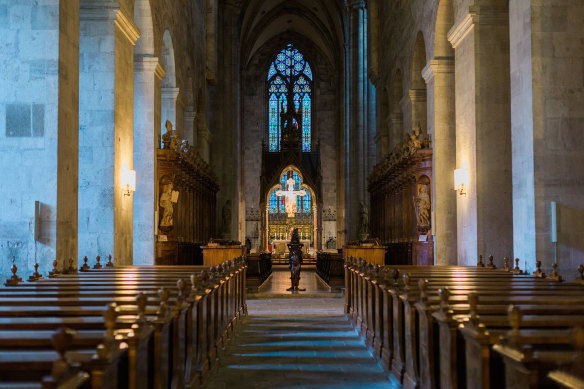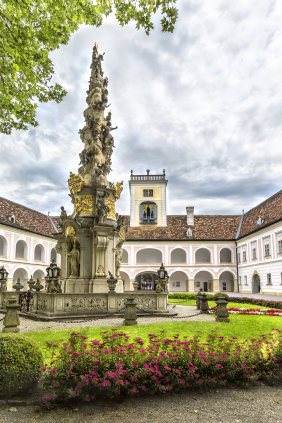Chants from the Vienna Woods
By Marian McGuinness
We’re driving deep into the Vienna Woods flanked by oak, beech and fir. A dirt path trails off. At first, it’s in the light, then dappled, then dark as the woods claim the imaginary walker.
Many composers were inspired by these enigmatic surrounds. Beethoven, Berlioz, Mahler, Schubert, Schumann, Johann Strauss, Richard Strauss and more. Each in awe of nature, wandering with their knapsacks on their backs, painting in music what they saw and heard. I’m on a cultural tour with Limelight Arts Travel, in a coach named Mozart, heading from Vienna towards Bohemia.
We stop mid-woods at the Heiligenkreuz Abbey (the Holy Cross Monastery), named for a relic of the cross brought here after the third crusade. It is the world’s oldest continuously active monastery – established in 1133, it is celebrating its 890th year.

Inside the Abbey.Credit: iStock
The cloistered courtyard is a place of prayer and meditation. At its centre is a golden baroque column glorifying the Holy Trinity and the ascension of Mary. It is circled by lime trees popping with iridescent spring leaves that filter the cobalt sky.
The abbey is a curious combination of medieval architecture to which Romanesque, Gothic and Baroque components were later added.
There is beauty in every detail: the marble columns, ancient door hinges, fading frescoes and medieval tombstones. Instead of a cascade of colours, the stained-glass windows were crafted in black and white geometry representing the simple life.
I peep through wrought iron gates into the vaulted mint-and-rose Chapel of the Dead where deceased monks are placed for a 24-hour vigil before burial. It’s the macabre guard-of-honour candlesticks that tickle my irony bone. Their tallow candles are held high by hip-swinging, bronze skeletons.
We are taken into the Frateria, the monks’ workroom, where back in the day it would have been a stone-cold scene of shoemakers, tailors and joiners.
Leading off to the right is the scriptorium. Being a scribe was a prized job as their frigid room was warmed by the calefactory below (the only room with a fireplace where monks warmed themselves after a long work day). The rising heat also kept the liturgical, medical and scientific manuscripts safe from damp. Unbeknown to the scribes and illuminators were the toxic perils of lead, mercury and arsenic used in their pigments.
Just before noon, our group files into the church. The spice of incense and varnish catches my breath. I have garnered a front pew as we face the parallel lines of choir stalls. I am in view of the hefty, illustrated book of Gregorian chant opened on the lectern where I see the four-line staves with square medieval notation. My teenager years as a church choir singer bode well for recognising many Latin words. Recently, the monks’ album of 900-year-old melodies, Chant: Music for Paradise was a worldwide hit.

Abbey of the Holy Cross (Stift Heiligenkreuz) – the world’s oldest continuously occupied Cistercian monastery.Credit: iStock
All is hushed as the noon bells peal. One by one, 50 Cistercian monks in wafting white cowls, process to the choir stalls and open their prayer books. The monk with green and gold tassels hanging from the end of his hood stands before the lectern and begins the chant. The monks softly echo, gentle in their harmony. Every now and then they bow and another cantor takes over as the chant swells and echoes. I smile as an older monk yawns. Who can blame him, starting his day with the 5.15am vigil.
To my side is the grandiose organ that Anton Bruckner played and where Franz Schubert composed his Fugue for Four Hands. I contemplate how so many sacred places teeter on survival’s edge. In 1683 the monastery was set on fire by invading Ottomans and during the Nazi reign most of its possessions were stolen while many monks were imprisoned.
As reverently as they came, the monks leave their choir stalls and follow in silent procession from the church.
The lights are turned off and we are gestured to leave, in body, if not in mind. As if this were all illusion.
THE DETAILS
TOUR
Limelight Arts Travel specialises in expert-led small group journeys exploring art, music, history and culture in Australia and overseas. Each tour is unique – “A Musical Christmas” is another musical tour that focuses on Austria: Salzburg, Linz, Graz and Vienna, from $11,900 a person, twin share. See limelight-arts-travel.com.au
For more on Heiligenkreuz Abbey, see stift-heiligenkreuz.org
The writer was a guest of Limelight Arts Travel
Sign up for the Traveller Deals newsletter
Get exclusive travel deals delivered straight to your inbox. Sign up now.